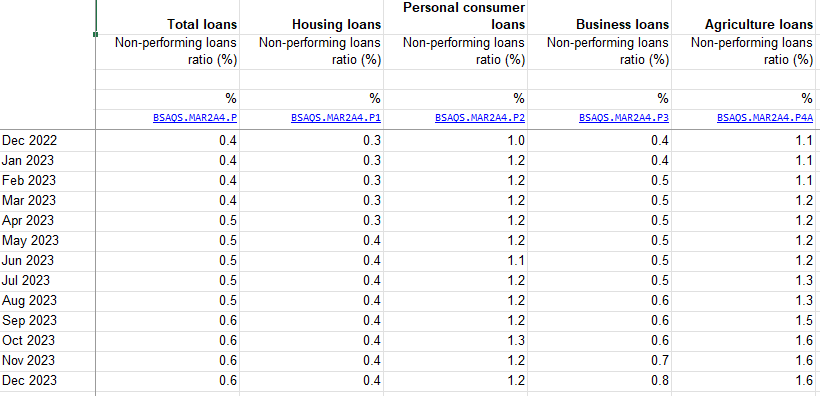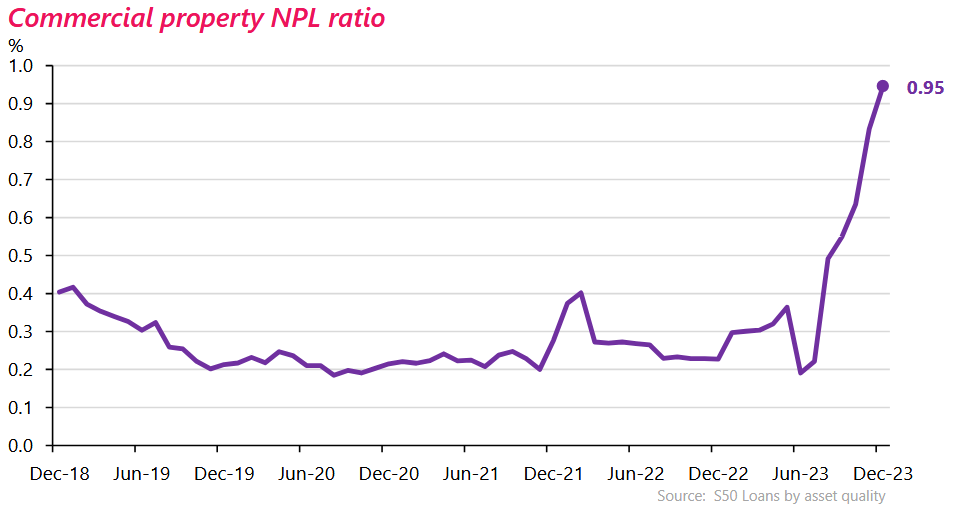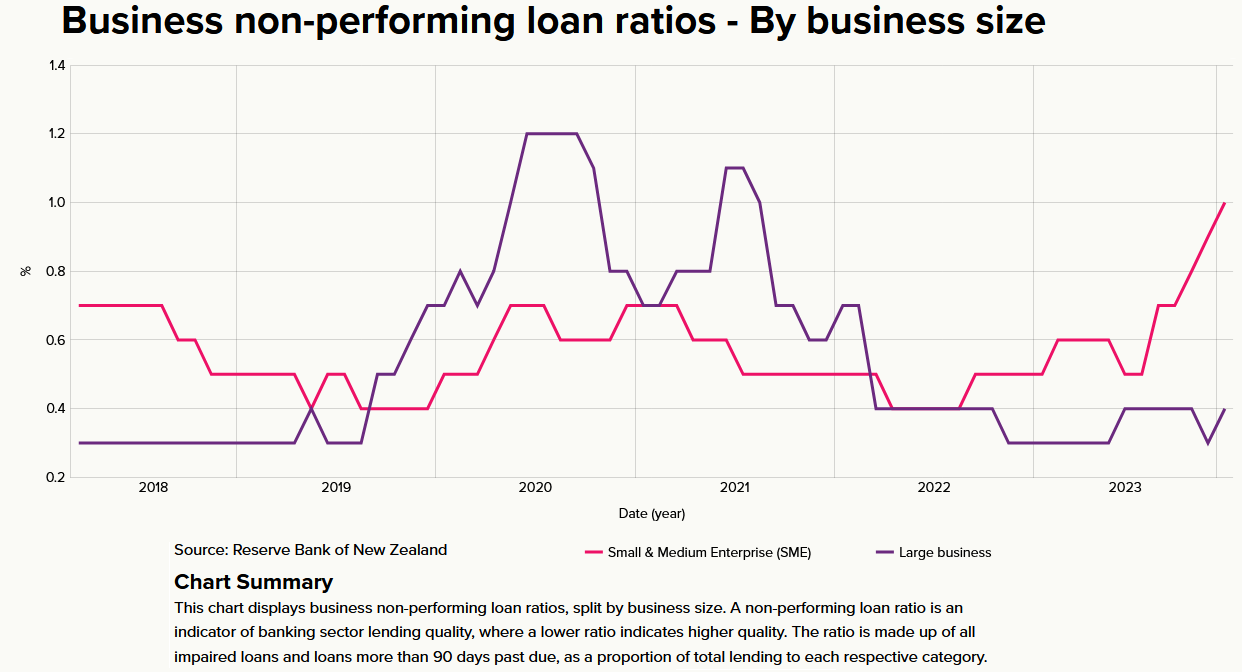
Non-performing housing loans topped the $1.5 billion mark at the end of 2023 and rose by some 78.5% ($667 million) during the year.
This is according to the latest Reserve Bank loans by asset quality figures for December, which give the total non-performing housing loans as $1.517 billion at the end of 2023, up from $850 million as at December 2022.
That's the 'headline' news if you like, but to give it some perspective, the latest non-performing loan figure represents 0.43% of total housing loans ($349.687 billion). And while that percentage is up from 0.25% as of the end of 2022, it's rising from a very low base and compares with peak non-performing levels of 1.2% that were seen between 2009 and 2011.
The RBNZ figures show that the non-performing home loans figure rose by $34 million between November 2023 and December 2023 and there's no obvious sign at this stage of a particularly worsening or increasing rate of stress in the face of the much higher interest costs that householders are now facing.
Separate data from the RBNZ shows that the interest bill for NZ's mortgage holders in 2023 was a whopping $17.694 billion, which was up from $11.999 billion in 2022 - a 47.5% increase.
As a personal comment, I would have expected a sharper rise in non-performing housing loans given the sheer size of some of the loans taken out during the period in which interest rates were at such historically low levels - and the subsequent massive hikes seen, which have seen increases in the order of over 50% for some monthly payment bills.
But it does have to be taken into account that a lot of households appear to have built good buffers for themselves in the 2020-21 pandemic period when interest rates were virtually non-existent.
So, it then becomes a question of whether we will see an increase in those stress levels as buffers run out - and for how long will interest rates stay at these levels.
Looking beyond housing, we can see that some definite pockets of stress are forming within the economy. The commercial property sector has seen a sharp rise in non-performing loan levels over the past 12 months - again from low levels. And within business lending, the small and medium sized enterprises (SMEs) have seen some big rises and this looks like a worsening trend.
The RBNZ's published information on the detailed sectoral lending breakdown goes back just to 2018, but there is a 'long-run' series that takes in the the overall non-performing loan ratios going back to 2008, and so this captures the post-GFC high levels.
Here is an edited version of the RBNZ spreadsheet from this series that shows what's happened to the various non-performing loan levels over 2023.

To fill in some detail, the total 'system' non-performing loans as at December 2023 were $3.552 billion, which makes up 0.64% of the total loans of $556.605 billion.
As at December 2022 the system wide non-performing loans had stood at $2.143 billion.
To give historical perspective, the peak system non-performing loans percentage hit was some 2.2% in 2011 - so we are a long way shy of that at the moment.
In terms of business loans, the rise from a non-performing ratio of just 0.4% in December 2022 to 0.8% a year later is quite sharp - but again the figure is well short of the post GFC high, which was 3.0% in 2011. Likewise the agriculture figure is up, but the 1.6% as of December 2023 compares with a post GFC high of 4.5% in 2011.
To go back to some of those particular pockets of stress that are forming, however, we can see that non-performing commercial property loans have exactly quadrupled during the past year, rising from $101 million in December 2022 to $404 million in December 2023. The percentage of non-performing commercial property loans has risen from 0.2% to 09% in that period, with total commercial property loans standing at $42.751 billion.
Worryingly, much of the increase in the non-performing loan levels for commercial property came in the second half of 2023.

And then there's the SMEs. The RBNZ's detailed business loans data shows that large business loans are looking fairly robust. But there's signs that the position for SMEs has deteriorated quite sharply as 2023 has gone on.
Non-performing loans for SMEs more than doubled during 2023 to $758 million from $366 million and most of this increase came in the second half of the year.
The percentage of non-performing loans by amount went from 0.5% to 1.0%. The total amount of loans is $76.385 billion. It's worth noting also that the total amount has dropped during the year from $78.085 billion as at December 2022.
I guess the question with all of the figures quoted in this article is: Will this prove to be the peak of stress, or is there more to come? The SME and commercial property figures particularly, and the sharp deterioration of those figures in the back half of 2023, don't seem to bode well.

50 Comments
re ... "...would be interesting to see if the trend followed a similar slope prior to GFC."
Way ahead of you. See my comment below with links to graphs.
(FWIW - it isn't interesting to many of us. Why? Because once a ship the size of the Seawise Giant gets on a course, it takes a huge amount of time and distance to change course. Captains of ships this size must make course and speed adjustments a long, long time before they are required. Further, they steer courses very conservatively to avoid damage to the ship and it's cargo. Clearly the RBNZ's MPC have never been to sea in large ship. Had they, they would have realised a course adjustment was required in November, 23.)
Edited: Yes. We can see the rocks ahead of us but now there is nothing that can be done. We can only watch as destruction comes closer and closer. And by the way, there aren't enough life boats. Nor are any still available as "those in know" have already abandoned ship.)
As a personal comment, I would have expected a sharper rise in non-performing housing loans given the sheer size of some of the loans taken out during the period in which interest rates were at such historically low levels - and the subsequent massive increases seen, which have seen increases in the order of over 50% for some monthly payment bills.
Yep, my tought also! Maybe the real pain is yet to come in 2024?
Meanwhile, over on Stuff...
Mortgage pain hits - why can’t we use our money to clear it? https://www.stuff.co.nz/money/350163831/mortgage-pain-hits-why-cant-we-…
The lady is 62. Why cant she access HER Kiwisaver to pay off the balance of HER mortgage and agree not to sell the house until she is 65 (when she could access the Kiwisaver money anyway). Decisions being made by people that don't understand what financial stress is.
The lady is a full grown adult that signed up to a scheme full well knowing the rules around withdrawing.
Mind you, people of that age have a habit of shirking minor details/risks and then expecting everybody else to pander to their oversights. Maybe South Canterbury Finance set a precedent?
Two mortgages totalling only $65k? And the bank telling them to extend to 10 years? They didn't want to extend because they'll 'pay more interest'. Interest over 10 years just isn't that much, if it keeps the roof over their heads. Still way cheaper than renting. And I'm willing to bet they have a chunk of equity that could be used to downsize/relocate also.
They are not in hardship - they are choosing not to take the paths offered. Remember - kiwisaver hardship withdrawal is only allowed to be used for living costs - even it the debt is what puts you in hardship, you're not allowed to use it for the debt, as there are other paths legally available to deal with the debt costs (such as SOE, NAP, etc.). And at 62, she could go find a job (ageism aside) instead of riding his super coattails (which is probably why they were able to survive prior on a low-income business).
Are these Non Performing loans defined as loans where the borrower has not paid any interest or principal for 90 days or more? So for an 800k mortgage they are already at least 15K behind in interest.
Potentially 2000 borrowers in this situation now. I assume that bank would have already tried to work with those borrowers to restructure the loans if it was possible. But the borrowers are now in the denial phase and waiting for whatever comes. The incentive for the big 4 banks would be to delay foreclosure as long as possible. Trickle the mortgagee sales into the market as to not distort the market and protect the underlying security for all their home loans.
Add in those SME loans that are secured against residential housing but classified as business lending. Don't imagine that anyone gets a significant business loan unless they have property as security.
How many loans are stage 2. Underperforming where the borrower has made at least some payments within the previous 90 days. But not enough to cover the payments that were due. I suspect its a way higher % number.
I'd also like to see how much debt has been added when banks 'helpfully' assist borrowers to 'restructure' their loans.
I'd also like to know how many times banks have 'recommended' (forcefully or otherwise) that people sell as they believe there is no hope for the borrower.
Banks will be doing everything in their power to (a) conceal the scale of mortgage stress; (b) delay consequences for failed mortgage holders. The former would hurt confidence in the housing market; the latter would directly lower prices by increasing supply. Banks are so vulnerable to a further fall in house prices that they can't afford to manage struggling mortgagors responsibly - they will string them along with interest only periods, mortgage holidays and other obfuscatory measures which ultimately only make the debt even harder to repay.
So over the pond we have quantitive tightening and higher for longer. The very little brother RBNZ will do the same; equals more pain. The real question is will their institutional slow motion bias push us into recession. Here it’s more likely than the USA which I would put at 50:50. The inverted yield curve over there has never resulted in anything in financial history other than a recession.🤷🏻♂️
Thanks David. Timely article.
One should point out that when references are made to the GFC, the damage from non-performing loans came well after the GFC had peaked.
Those with long enough memories, or who use interest.co.nz's excellent series of charts (like this one), will know much of the damage was done after the RBNZ had slashed the OCR from pre-GFC levels of 8.25% in Jul 2008 down to just 2.5% in April, 2009 (with banks being slow to pass it on, as usual). Read those rates and dates again. Let them sink in.
So where are we know? David gives us the link to the RBNZ graph above, and for quick reference it is here too. Note the peak came March, 2011. Read that date again. A full two years AFTER the OCR dropped to just 2.5%.
Many of us argue that central banks created the GFC by persisting with outdated tools in an attempt to hammer inflation. Instead, central banks ignored our logic and created a world wide recession from which the rich became even richer while the average Joe got absolutely clobbered.
Split Enz sung that History Never Repeats. Alas, it will. Our central bankers and governments have learned nothing. Or maybe they're not really working for us at all?
We live in a world where the rich have the knowledge, education, resources but most importantly influence to gain wealth at an exponential rate at the expense of the rest. Capitalism as intended, consolidation of power. Sad to see so many SME's struggling as when small businesses, which bring variety, life and culture to places, start failing, then the big players with enough buffer to stay afloat simply come in and take over. I wonder if in 10-20years we will simply have the same chain stores everywhere in every town and city as they have survived the downturns and pushed out the small businesses by then. Drastic sentiment, yes, but an interesting line of thought nonetheless.
It would be interesting to see more cooperatives coming about in the next decade, to perhaps benefit from disintermediating some models.
For example, some egg farmers were hit hard by the Supermarket Duopoly's decision not to carry colony eggs, because the farmers had inadequate other routes to market. In another industry, online discussion is highlighting a major logistics company seemingly becoming little more than a software/service platform company that links truck owners with customers while squeezing them both. Cooperative models could be an interesting alternative to Chokepoint Economics.
100% Agree.
More cooperatives, as they have in many of the economies that work best for people as a whole, would ensure for-profit companies were kept in check. I'm staggered that we've had so many (supposedly) left-leaning governments and yet we have no major banking co-op, or insurance co-op. Shame on them.
And yet we're the ones enabling it.
Isn't that the plan of the WEF - you will own nothing and be happy - yet something will own it all. Most likely a small group of financial institutions.
What's even more funny is our ancestors, many spiritual philosophies and indigenous peoples taught the same thing, only in a way that benefited the many, not the few.
Capitalism seems to have corrupted many values.
Looks like humanity is at a serious crossroads...
As I have said in other articles, I have seen two situations in the last few months where borrowers have simply failed to pay the mortgage for over a year (no application for mortgage holiday, interest only, etc.) and the banks have done nothing. I wonder how long before they decide they need to crack down on this as a deterrent for others.
So the RBNZ, by mandate, had to increase the OCR and removes $5.7 billion from the economy to tame inflation.
In the same year Government invests an additional $5.9 billion and we were all told that increased Government spending is not inflationary. If they didn’t spend the additional $5.9 billion then perhaps the RBNZ would not have raise interest rates to remove the $5.7 billion from households and the private sector.
Remarkable coincidence.
Exert from the Finance Minister Well Being Budget 2022 Speech - “Budget 2022 invests $5.9 billion a year in net new operating spending, while introducing multi-year funding packages that also draw from Budget 2023 and Budget 2024 operating allowances”.


We welcome your comments below. If you are not already registered, please register to comment.
Remember we welcome robust, respectful and insightful debate. We don't welcome abusive or defamatory comments and will de-register those repeatedly making such comments. Our current comment policy is here.